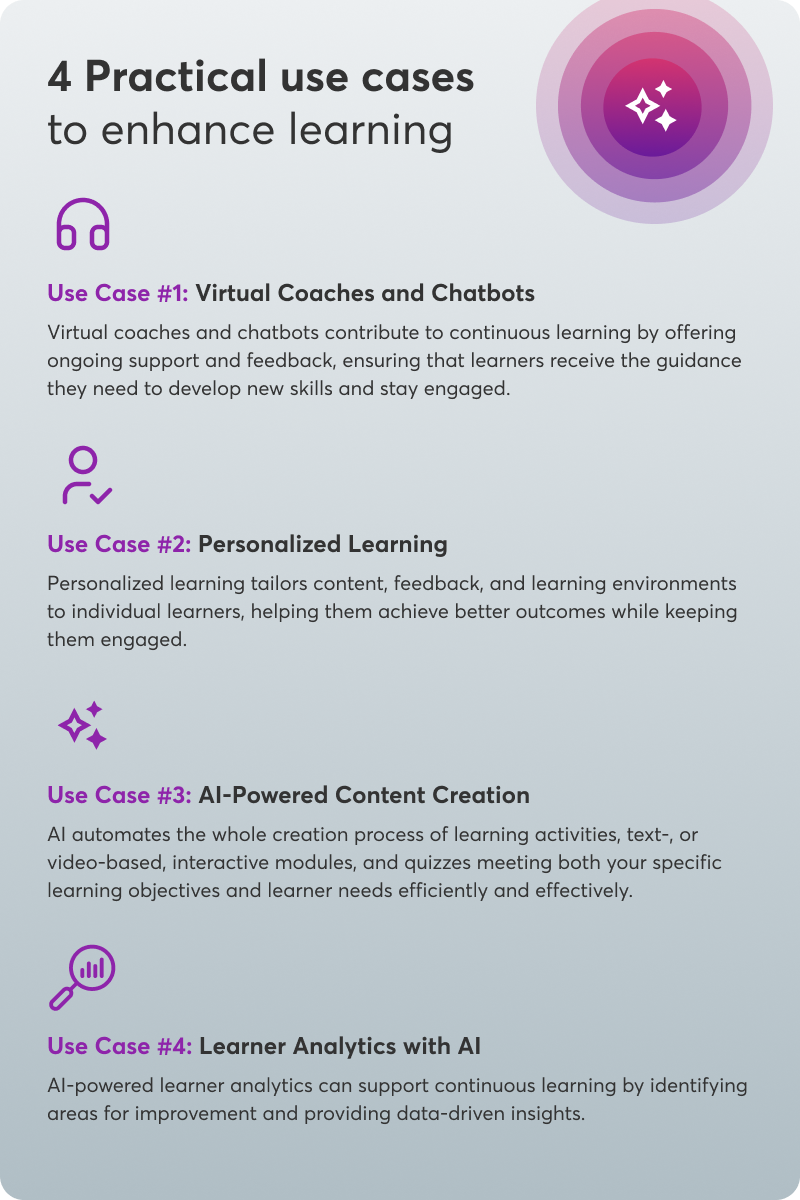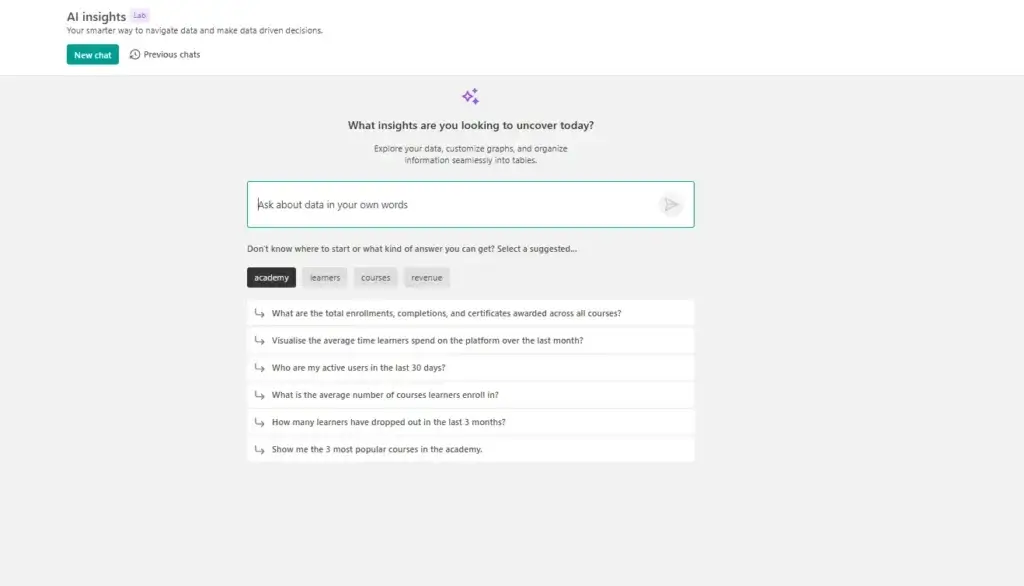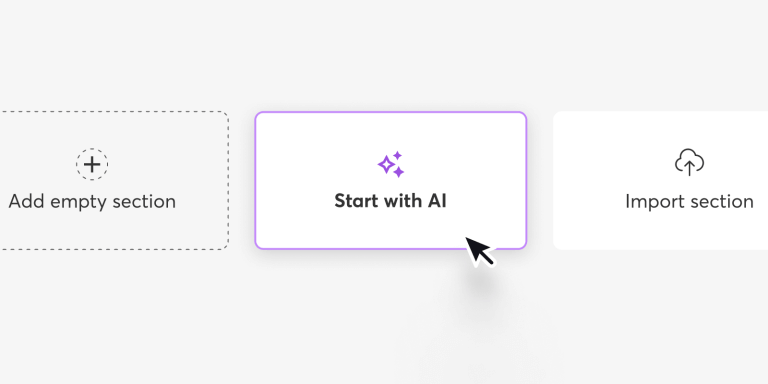Table of Contents
You are here because you want to power up your learning programs—and generative Artificial Intelligence (AI) is the tool to make it happen. In the 2024 L&D Global Sentiment Survey, this new technology secured an unprecedented 21.5% of the global vote, underscoring the transformative potential of AI in learning and development, as well as its other two newly-adopted roles in directly relevant applications: AI in training and development, and AI in training initiatives on a wider scale.
It’s true that generative AI can do lots of things. Apart from automating repetitive tasks, adding a personalization tone to the learning process, and delivering actionable insights, it also has the power to equip L&D leaders with the information to tackle multiple challenges. These more often than not, include low engagement rates, outdated systems, and proving ROI.
That’s why in this article, we will explore the benefits and challenges linked with AI use, as well as the top applications of AI in L&D.
Discover LearnWorlds AI-Powered Tools
Key takeaways
When talking about AI in learning and development, there are a few things to have in mind. These are the key takeaways from this article:
Definition of AI in learning and development
Artificial intelligence in learning and development involves making use of generative AI technologies to enhance education and training processes. These tools use machine learning techniques – these are deep learning models like neural networks and natural language processing, to produce various outputs that include text, images, video, and music.
This process of content generation supports the instructional design of course creators – educators and trainers, allowing them to create personalized learning experiences. In several settings like in corporate training for example this level of personalization can enhance employee development and productivity.
But let’s go through all the advantages AI can offer to learning and development.
Benefits of AI in learning and development
LinkedIn’s Workplace Learning report shows that 8 in 10 employees say learning adds purpose to their work. With that ratio in mind, companies that prioritize employee skill development while using AI are more likely to see increased retention, productivity, and alignment in their goals.
Suppose they rely on AI-powered learning systems to deploy AI tools for training and development, they can offer personalized training that aligns with specific learner needs and business objectives.
Therefore it is safe to say that when artificial intelligence in workforce training is used strategically, it can enhance performance.
So, how can AI practically transform your learning programs and bring measurable results?
Let’s dive deeper into the key benefits of AI in learning and development to find out how it can reshape workforce training for your organization for the better.
Bridge skill gaps
The skill gaps in your employees are the missing pieces of a puzzle. Learning about and filling out those skills shortages in your workforce is made easier by using generative AI.
Let’s say that your marketing team excels at creative campaigns but struggles with data analytics. What AI can do is identify this gap through performance data analysis and recommend analytics training specific to their positions.
Instead of wasting time going through long unuseful modules, your team members develop the skills that are crucial to them, while making sure they are in line with corporate objectives and prepared for the future.
Provide proactive learner support
“I hit a wall halfway through the module, and I had no one to turn to.” Does that sound familiar? Virtual assistants and AI chatbots are here to offer their assistance when learners need solutions to their problems and need them fast.
Think about a worker who cannot attend a cybersecurity course in the evening hours. Well, he or she can go through the lesson alone, get the clarification they request, and maintain their motivation to finish the course by asking a brief inquiry of the chatbot. AI, in this case, ensures that learners never get stuck, making the training easy and frustration-free.
Analyze advanced data insights
The effectiveness of traditional staff training programs is frequently left up in the air but AI analytics can act as your compass providing you with clear insights. This AI-powered advanced data can point out patterns and improvement areas that you need to work on.
For example, AI may find significant drop-off rates in your leadership program. Knowing this, you can choose to divide the material into smaller and more manageable chunks of information, embracing microlearning, and ultimately increasing your completion rates and satisfaction rates.
This way, AI helps you make data-driven decisions that aim to improve learner outcomes and also support your organizational objectives.
💁Learn how to train AI with use cases and prompts to help you build AI-powered learning objectives and create engaging educational texts.
Challenges of implementing AI in learning and development
Even though AI in L&D offers several transformative benefits, putting it into actual practice has its own set of limitations and difficulties just like you would expect from any significant innovation.
Either way, you shouldn’t let these challenges stop you. The first step to maximizing AI’s potential and making it work for your company is to recognize and resolve them.
Now let’s talk about the main obstacles you may encounter and suggest a few ways how to overcome them.
Seamless integration
At first, you may feel that integrating AI with your current systems is not as easy as expected, and that’s OK. The shift that takes you from conventional training models to AI-driven systems can be challenging, and AI tools frequently need to be able to work with Learning Management Systems (LMS).
Many businesses find it complex to incorporate them as new tools without interfering with their current processes. The same LinkedIn study confirms that system integration is actually the biggest obstacle for firms when trying to implement new technology.
Budget considerations
Even though AI can save you money in the long run, the initial costs may seem high. Adopting AI requires a large upfront expense commitment so that you can cover everything from software licenses and infrastructure upgrades to personnel training.
This, however, can be a deal-breaker if you have a small business and realistically speaking, we can only expect that the expenses of AI will increase as it grows further.
Skilled talent acquisition
AI systems don’t operate on their own, which means they will require human management and frequent optimization. Hiring skilled data scientists or AI experts though can be challenging, especially for businesses going after the same talent pool as tech giants.
Not to mention, the demand for AI professionals is significantly bigger than the supply, which results in a well-documented global scarcity.
Supporting infrastructure
Although AI has great potential, it requires a solid basis to succeed. To make this happen, you will also need a reliable IT infrastructure. That is cloud computing capabilities, safe data storage, and seamless communication to help you implement AI solutions effectively.
Adopting this kind of infrastructure may be a significant obstacle for smaller enterprises.
Risk of overestimation
Relying too much on AI might result in irrational expectations, like believing that technology can completely replace human expertise, but that’s not the case. AI-driven tools may still generate unhelpful or even detrimental results if you don’t supervise them properly.
-
-
-
-
-
- 💁Read more about artificial intelligence in training and the rise of artificial intelligence in learning.
-
-
-
-
4 use cases to enhance learning
Now that we have reviewed the possible challenges that may come with generative AI, it’s time to see how it can assist you in addressing poor learner participation rates, replacing old procedures, and even scaling your learning and development AI initiatives.

Use case #1: Virtual coaches and chatbots
The difficulty of maintaining learners’ support and engagement during their training is real. However, as we have seen this can be easily addressed with the use of virtual coaches and AI-powered chatbots, which provide personalized, and real-time feedback that is crucial for learning retention.
These chatbots and virtual coaches help by providing continuous support and feedback to learners allowing them to stay motivated throughout their educational journey.
A UniDistance Suisse study found that students who used an AI tutor received marks that were up to 15 percentile points higher than those of their counterparts in a course without AI.
This is credited to the AI’s capacity to offer real-time support and consistent feedback that improves comprehension.
💡Why it matters to you: Chatbots and virtual coaches can improve the performance of your learning programs while offering feedback that aids in skill mastery and taking care of repetitive support requests. Your programs are likely to be more scalable and effective as a result of this combination. This also guarantees that your learners stay on course and relieves the workload of your L&D team.
Practical steps for implementation:
Example in action: Imagine a training situation where a learner is having trouble understanding a complex concept. They get immediate, personalized feedback from a virtual coach rather than having to wait for the live trainer or teacher’s input. In the meantime, the chatbot provides quick answers to common queries like “How do I access my next module?” keeping the learners focused on their goals.
Practical tips:
In addition to keeping learners encouraged and involved, virtual coaches and chatbots help to build a more dynamic and responsive learning environment where all inquiries are addressed and each learner feels empowered and guided to success.
Use case #2: Personalized learning
How can you make sure that each learner’s training is tailored to their individual abilities, areas of knowledge deficiency, and advancement? As mentioned earlier, AI-powered personalized learning is the answer. This approach customizes learning settings, feedback, and information for each learner to ensure their interest levels remain high while helping them attain higher results.
The benefits of individualized adaptive learning platforms are regularly highlighted by research.
A recent systematic review found that AI-driven adaptive learning systems can boost learner motivation by attending to their individual demands, like learning objectives or knowledge gaps. To keep training current and efficient, these systems also use real-time data to suggest and modify content.
💡Why it matters to you: Making sure the content is adapted to each individual and allows learners to receive the right material at the right time. Check the materials as well so that it does not overwhelm them or boring them with content they have already mastered. This strategy leads to improved knowledge retention, faster skills acquisition, lower learner disengagement, and, ultimately, improved ROI for your learning programs.
Practical steps for implementation:
Example in action: Consider individualized learning as providing each learner with a skilled mentor. For example, an AI-powered application may examine performance data from an employee and identify great technical talents but poor presenting skills. Public speaking classes are given priority by the system, which guarantees that learners avoid unnecessary technical material and concentrate on areas with the biggest room for improvement.
Practical tips:
On top of addressing the unique needs of each student, personalized learning helps in increasing productivity, retention, and engagement in quantifiable ways.
Use case #3: AI-powered content creation
Did you know that 25% of L&D professionals think AI is enabling them to produce learning materials more quickly and with higher quality? AI-powered content creation tools are changing the way businesses plan and execute training and development programs in response to the increased need for engaging and up-to-date learning resources.
These technologies allow you to effectively and efficiently fulfill the demands of your learners as well as your specific learning objectives. They do this by automating the entire process of creating interactive modules, quizzes, and learning activities (either based on text or video).
💡Why it matters to you: Another difficult task for L&D professionals is producing training materials that have an impact, particularly when faced with a variety of learner demands, complex subject matter, and short turnaround times. But when automating repetitive processes like writing scripts, editing videos, and making ebooks with AI, you free up your time to focus on producing high-quality material that improves the learning process.
These tools also provide unmatched flexibility. Whether you are applying multiple training methods like role-specific training or offering multilingual modules for a worldwide workforce, AI guarantees scalability and consistency while saving production time.
Practical steps for implementation:
Example in action: Suppose that your company requires a product training module for staff members who work in various locations. Without employing a video production crew, you may produce a multilingual, high-quality video with a program like Synthesia. When used in combination with LearnWorlds, you get to develop AI-powered quizzes that enhance learning and guarantee that your staff members understand key ideas while interacting with the material.
Practical tips:
You can create dynamic and excellent training materials that keep learners interested and aligned with corporate objectives by using AI-powered content production. Doing so will help you increase your training efforts without having to sacrifice quality or relevance.
Use Case #4: Learner Analytics with AI
A lot of learning and development experts think that AI-powered learner analytics is a luxury that only big businesses with limitless funds and resources can afford. The reality? Businesses of all sizes may now make use of AI analytics solutions because they are becoming more widely available, reasonably priced, and scalable.
Learner analytics enabled by AI can aid continuous learning by pointing out areas that need work and offering insights based on data.
💡Why it matters to you: As an L&D professional, you are always required to demonstrate the return on investment (ROI) of your training initiatives while making sure they align with the company objectives. This is made easier with AI analytics, which uses employee data to find trends, gaps, and opportunities in learner behavior so you can improve your training delivery and content strategies.
AI analytics, for example, can identify learners who are in danger of falling behind, allowing you to take early action and offer targeted support. Because training investments result in measurable increases in productivity and skill development, this guarantees better outcomes for both the learners and the company.
Practical steps for implementation:
Example in action: Imagine your sales team is undergoing product training. Whey using AI analytics, you discover that most participants struggle with the negotiation skills module, resulting in low quiz scores. Through the help of these insights, you can now refine the module, introduce additional resources, or even schedule live coaching sessions to bridge the gap.
Practical tips:
On top of monitoring data, AI-driven learner analytics can help you develop a data-driven plan that improves your educational and training initiatives and gives learners the tools they need to succeed.
Final thoughts
Spend some time assessing your organization’s readiness before starting to use AI and make sure you introduce the necessary tools to your staff. As it seems now AI and learning go hand-in-hand and it’s crucial to give them the space to experiment on how to use AI to learn. The IBM Watson AI Readiness Tool or the Microsoft AI Readiness Framework are two tools that you can use to gather important information about where you are right now.
These assessments offer customized recommendations and can help you benchmark your capabilities against industry standards, but also identify areas for improvement in your AI training development initiatives.
Once you have assessed your readiness, make sure you:
You may choose to use gen AI in your company by carefully evaluating its readiness, establishing realistic objectives, and focusing on successful use cases. Although the path to investing in AI in learning and development and implementing AI-enhanced learning solutions may be difficult, the benefits are well worth the effort if you plan ahead and equip your team with the appropriate resources.
What are you planning to do next? Are you willing to invest in AI for training and development? If yes, we recommend putting your trust in an AI-powered LMS like LearnWorlds. Get your free trial today and start making use of AI tools for training and development purposes to help you build a future-ready workforce.
Resources
2024 L&D Global Sentiment Survey
Castro, G. P. B., Chiappe, A., Rodríguez, D. F. B., & Sepulveda, F. G. (2024). Harnessing AI for Education 4.0: Drivers of Personalized Learning. Electronic Journal of e-Learning, 22(5), 01-14. https://doi.org/10.34190/ejel.22.5.3467
Baillifard, A., Gabella, M., Lavenex, P. B., & Martarelli, C. S. (2023). Implementing Learning Principles with a Personal AI Tutor: A Case Study. arXiv preprint arXiv:2309.13060. https://arxiv.org/abs/2309.13060?
LinkedIn Learning Workplace Learning Report 2024
Microsoft AI Readiness Framework
Frequently Asked Questions (FAQs)
How can AI help in learning and development?
Artificial Intelligence personalizes training by tailoring content to learners’ needs, identifies skill gaps, and automates tasks like content creation. It also gives you data-driven insights, that help companies align training with business goals while improving engagement and effectiveness.
How are companies using AI for learning and development?
Learning and development AI practices can help companies use AI for personalized learning, virtual coaching, and advanced analytics to track engagement and measure ROI. They also leverage AI for faster content creation, such as quizzes and videos, making training programs more scalable and efficient.
How to use ChatGPT to create elearning content?
You can build elearning content and personalized training with AI using ChatGPT. The tool allows you to create course outlines, draft scripts, quizzes, and build interactive scenarios for training. AI in training and development applications can also support multilingual content creation, helping global teams scale teamwork, productivity, and success. Use learning platforms like LearnWorlds to generate AI content seamlessly into your LMS.
What is the difference between artificial intelligence and machine learning?
AI refers to systems designed to simulate human intelligence, while machine learning is a subset of AI that enables systems to learn and adapt from data without explicit programming. In short, ML helps AI systems improve over time.
Panagiota is an Instructional Technologies Specialist at LearnWorlds, holding a Ph.D. in Technology Enhanced Learning. Her research focuses on the integration of educational technologies into learning and instruction. In her spare time, she enjoys gardening and staying connected with nature.






